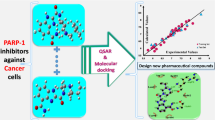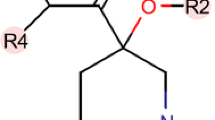Abstract
Cancer cells have upregulated DNA repair mechanisms, enabling them survive DNA damage induced during repeated rapid cell divisions and targeted chemotherapeutic treatments. Cancer cell proliferation and survival targeting via inhibition of DNA repair pathways is currently a very promiscuous anti-tumor approach. The deubiquitinating enzyme, USP1 is known to promote DNA repair via complexing with UAF1. The USP1/UAF1 complex is responsible for regulating DNA break repair pathways such as trans-lesion synthesis pathway, Fanconi anemia pathway and homologous recombination. Thus, USP1/UAF1 inhibition poses as an efficient anti-cancer strategy. The recently made available high throughput screen data for anti USP1/UAF1 activity prompted us to compute bioactivity predictive models that could help in screening for potential USP1/UAF1 inhibitors having anti-cancer properties. The current study utilizes publicly available high throughput screen data set of chemical compounds evaluated for their potential USP1/UAF1 inhibitory effect. A machine learning approach was devised for generation of computational models that could predict for potential anti USP1/UAF1 biological activity of novel anticancer compounds. Additional efficacy of active compounds was screened by applying SMARTS filter to eliminate molecules with non-drug like features. The structural fragment analysis was further performed to explore structural properties of the molecules. We demonstrated that modern machine learning approaches could be efficiently employed in building predictive computational models and their predictive performance is statistically accurate. The structure fragment analysis revealed the structures that could play an important role in identification of USP1/UAF1 inhibitors.





Similar content being viewed by others
References
Amerik AY, Hochstrasser M (2004) Mechanism and function of deubiquitinating enzymes. Biochim Biophys Acta 1695:189–207
Baell JB, Holloway GA (2010) New substructure filters for removal of pan assay interference compounds (PAINS) from screening libraries and for their exclusion in bioassays. J Med Chem 53:2719–2740. doi:10.1021/jm901137j
Blagus R, Lusa L (2010) Class prediction for high-dimensional class-imbalanced data. BMC Bioinformatics 11:523. doi:10.1186/1471-2105-11-523
Bouckaert RR, Frank E, Hall MA, Holmes G, Pfahringer B, Reutemann P et al. (2010) Weka—Experiences with a Java Open-Source Project. J Mach Learn Res 10:2533–2541
Branzei D, Foiani M (2008) Regulation of DNA repair throughout the cell cycle. Nat Rev Mol Cell Biol 9:297–308. doi:10.1038/nrm2351
Breiman L (2001) Random forests. Mach Learn 45:5–32. doi:10.1023/a:1010933404324
Chen ZJ, Sun LJ (2009) Nonproteolytic functions of ubiquitin in cell signaling. Mol Cell 33:275–286. doi:10.1016/j.molcel.2009.01.014
Cheng F et al (2011) Classification of cytochrome P450 inhibitors and noninhibitors using combined classifiers. J Chem Inf Model 51:996–1011. doi:10.1021/ci200028n
Cohn MA, Kowal P, Yang K, Haas W, Huang TT, Gygi SP, D’Andrea AD (2007) A UAF1-containing multisubunit protein complex regulates the Fanconi anemia pathway. Mol Cell 28:786–797
Cohn MA, Kee Y, Haas W, Gygi SP, D’Andrea AD (2009) UAF1 is a subunit of multiple deubiquitinating enzyme complexes. J Biol Chem 284:5343–5351. doi:10.1074/jbc.M808430200
Cortes CVV (1995) Support vector networks. Mach Learn 20:273–297
Curtin NJ (2012) DNA repair dysregulation from cancer driver to therapeutic target. Nat Rev Cancer 12:801–817. doi:10.1038/nrc3399
Dhanjal JK, Goyal S, Sharma S, Hamid R, Grover A (2014) Mechanistic insights into mode of action of potent natural antagonists of BACE-1 for checking Alzheimer’s plaque pathology. Biochem Biophys Res Commun 443:1054–1059
Dudek AZ, Arodz T, Galvez J (2006) Computational methods in developing quantitative structure-activity relationships (QSAR): a review. Comb Chem High Throughput Screen 9:213–228
Elkan C (2001) The foundations of cost-sensitive learning. In: Proceedings of the Seventeenth International Joint Conference on Artificial Intelligence, vol 2. pp 973–978
Fong S, Debs RJ, Desprez PY (2004) Id genes and proteins as promising targets in cancer therapy. Trends Mol Med 10:387–392. doi:10.1016/j.molmed.2004.06.008
Fraile JM, Quesada V, Rodriguez D, Freije JM, Lopez-Otin C (2012) Deubiquitinases in cancer: new functions and therapeutic options. Oncogene 31:2373–2388. doi:10.1038/onc.2011.443
Friedman N, Geiger D, Goldszmidt M (1997) Bayesian network classifiers. Mach Learn 29:131–163. doi:10.1023/a:1007465528199
Garcia-Santisteban I, Peters GJ, Giovannetti E, Rodriguez JA (2013) USP1 deubiquitinase: cellular functions, regulatory mechanisms and emerging potential as target in cancer therapy. Mol Cancer 12:91. doi:10.1186/1476-4598-12-91
Goyal M, Dhanjal JK, Goyal S, Tyagi C, Hamid R, Grover A (2014) Development of dual inhibitors against Alzheimer’s disease using fragment-based QSAR and molecular docking. BioMed Res Int 2014:979606. doi:10.1155/2014/979606
Hann M, Hudson B, Lewell X, Lifely R, Miller L, Ramsden N (1999) Strategic pooling of compounds for high-throughput screening. J Chem Inf Comput Sci 39:897–902
Helleday T, Petermann E, Lundin C, Hodgson B, Sharma RA (2008) DNA repair pathways as targets for cancer therapy. Nat Rev Cancer 8:193–204. doi:10.1038/nrc2342
Hoeller D, Dikic I (2009) Targeting the ubiquitin system in cancer therapy. Nature 458:438–444. doi:10.1038/nature07960
Hofmann K (2009) Ubiquitin-binding domains and their role in the DNA damage response. DNA Repair (Amst) 8:544–556. doi:10.1016/j.dnarep.2009.01.003
Huang TT, D’Andrea AD (2006) Regulation of DNA repair by ubiquitylation. Nat Rev Mol Cell Biol 7:323–334. doi:10.1038/nrm1908
Huang TT et al (2006) Regulation of monoubiquitinated PCNA by DUB autocleavage. Nat Cell Biol 8:339–347. doi:10.1038/ncb1378
Hussain S, Zhang Y, Galardy PJ (2009) DUBs and cancer: the role of deubiquitinating enzymes as oncogenes, non-oncogenes and tumor suppressors. Cell Cycle 8:1688–1697
Huth JR et al (2005) ALARM NMR: a rapid and robust experimental method to detect reactive false positives in biochemical screens. J Am Chem Soc 127:217–224. doi:10.1021/ja0455547
Jamal S, Scaria V (2013) Cheminformatic models based on machine learning for pyruvate kinase inhibitors of Leishmania mexicana. BMC Bioinformatics 14:329. doi:10.1186/1471-2105-14-329
Jamal S, Periwal V, Scaria V (2013) Predictive modeling of anti-malarial molecules inhibiting apicoplast formation. BMC Bioinformatics 14:55. doi:10.1186/1471-2105-14-55
Japkowicz N (2000) The class imbalance problem: significance and strategies. In: Proceedings of the International Conference on Artificial Intelligence
Jensen LJ, Saric J, Bork P (2006) Literature mining for the biologist: from information retrieval to biological discovery. Nat Rev Genet 7:119–129. doi:10.1038/nrg1768
Jensen BF, Vind C, Padkjaer SB, Brockhoff PB, Refsgaard HH (2007) In silico prediction of cytochrome P450 2D6 and 3A4 inhibition using Gaussian kernel weighted k-nearest neighbor and extended connectivity fingerprints, including structural fragment analysis of inhibitors versus noninhibitors. J Med Chem 50:501–511. doi:10.1021/jm060333s
Jones MJ, Colnaghi L, Huang TT (2012) Dysregulation of DNA polymerase kappa recruitment to replication forks results in genomic instability. EMBO J 31:908–918. doi:10.1038/emboj.2011.457
Kannouche PL, Wing J, Lehmann AR (2004) Interaction of human DNA polymerase eta with monoubiquitinated PCNA: a possible mechanism for the polymerase switch in response to DNA damage. Mol Cell 14:491–500
Kennedy RD, D’Andrea AD (2006) DNA repair pathways in clinical practice: lessons from pediatric cancer susceptibility syndromes. J Clin Oncol 24:3799–3808
Kim H, D’Andrea AD (2012) Regulation of DNA cross-link repair by the Fanconi anemia/BRCA pathway. Genes Dev 26:1393–1408. doi:10.1101/gad.195248.112
Kim JM, Parmar K, Huang M, Weinstock DM, Ruit CA, Kutok JL, D’Andrea AD (2009) Inactivation of murine Usp1 results in genomic instability and a Fanconi anemia phenotype. Dev Cell 16:314–320. doi:10.1016/j.devcel.2009.01.001
Liang Q et al (2014) A selective USP1-UAF1 inhibitor links deubiquitination to DNA damage responses. Nat Chem Biol 10:298–304. doi:10.1038/nchembio.1455
Liu K, Feng J, Young SS (2005) PowerMV: a software environment for molecular viewing, descriptor generation, data analysis and hit evaluation. J Chem Inf Model 45:515–522. doi:10.1021/ci049847v
Melville JL, Burke EK, Hirst JD (2009) Machine learning in virtual screening. Comb Chem High Throughput Screen 12:332–343
Mistry H et al (2013) Small-molecule inhibitors of USP1 target ID1 degradation in leukemic cells. Mol Cancer Ther 12:2651–2662. doi:10.1158/1535-7163.MCT-13-0103-T
Murai J, Yang K, Dejsuphong D, Hirota K, Takeda S, D’Andrea AD (2011) The USP1/UAF1 complex promotes double-strand break repair through homologous recombination. Mol Cell Biol 31:2462–2469. doi:10.1128/mcb.05058-11
Nijman SM, Huang TT, Dirac AM, Brummelkamp TR, Kerkhoven RM, D’Andrea AD, Bernards R (2005a) The deubiquitinating enzyme USP1 regulates the Fanconi anemia pathway. Mol Cell 17:331–339
Nijman SM, Luna-Vargas MP, Velds A, Brummelkamp TR, Dirac AM, Sixma TK, Bernards R (2005b) A genomic and functional inventory of deubiquitinating enzymes. Cell 123:773–786
Oestergaard VH et al (2007) Deubiquitination of FANCD2 is required for DNA crosslink repair. Mol Cell 28:798–809. doi:10.1016/j.molcel.2007.09.020
Periwal V, Rajappan JK, Jaleel AU, Scaria V (2011) Predictive models for anti-tubercular molecules using machine learning on high-throughput biological screening datasets. BMC Res Notes 4:504. doi:10.1186/1756-0500-4-504
Periwal V, Kishtapuram S, Scaria V (2012) Computational models for in vitro anti-tubercular activity of molecules based on high-throughput chemical biology screening datasets. BMC Pharmacol 12:1. doi:10.1186/1471-2210-12-1
Quinlan JR (1993) C4.5 programs for machine learning. Morgan Kaufmann Publishers, San Francisco
Sacco JJ, Coulson JM, Clague MJ, Urbe S (2010) Emerging roles of deubiquitinases in cancer-associated pathways. IUBMB Life 62:140–157. doi:10.1002/iub.300
Schierz AC (2009) Virtual screening of bioassay data. J Cheminform 1:21. doi:10.1186/1758-2946-1-21
Shen J, Cheng F, Xu Y, Li W, Tang Y (2010) Estimation of ADME properties with substructure pattern recognition. J Chem Inf Model 50:1034–1041. doi:10.1021/ci100104j
Sims AE et al (2007) FANCI is a second monoubiquitinated member of the Fanconi anemia pathway. Nat Struct Mol Biol 14:564–567. doi:10.1038/nsmb1252
Sud M (2010) MayaChemTools. http://www.mayachemtools.org/
Ulrich HD, Walden H (2010) Ubiquitin signalling in DNA replication and repair. Nat Rev Mol Cell Biol 11:479–489. doi:10.1038/nrm2921
Villamil MA, Chen J, Liang Q, Zhuang Z (2012) A noncanonical cysteine protease USP1 is activated through active site modulation by USP1-associated factor 1. Biochemistry 51:2829–2839. doi:10.1021/bi3000512
Wang Y et al (2012) PubChem’s BioAssay Database. Nucleic Acids Res 40:D400–D412. doi:10.1093/nar/gkr1132
Williams SA et al (2011) USP1 deubiquitinates ID proteins to preserve a mesenchymal stem cell program in osteosarcoma. Cell 146:918–930. doi:10.1016/j.cell.2011.07.040
Zhuang Z, Johnson RE, Haracska L, Prakash L, Prakash S, Benkovic SJ (2008) Regulation of polymerase exchange between Poleta and Poldelta by monoubiquitination of PCNA and the movement of DNA polymerase holoenzyme. Proc Natl Acad Sci U S A 105:5361–5366. doi:10.1073/pnas.0801310105
Acknowledgments
AG is thankful to Jawaharlal Nehru University for usage of all computational facilities. AG is grateful to University Grants Commission, India for the Faculty Recharge position.
Conflict of interest
The authors declare that they have no conflict of interest.
Author information
Authors and Affiliations
Corresponding author
Electronic supplementary material
Below is the link to the electronic supplementary material.
Rights and permissions
About this article
Cite this article
Wahi, D., Jamal, S., Goyal, S. et al. Cheminformatics models based on machine learning approaches for design of USP1/UAF1 abrogators as anticancer agents. Syst Synth Biol 9, 33–43 (2015). https://doi.org/10.1007/s11693-015-9162-1
Received:
Revised:
Accepted:
Published:
Issue Date:
DOI: https://doi.org/10.1007/s11693-015-9162-1




